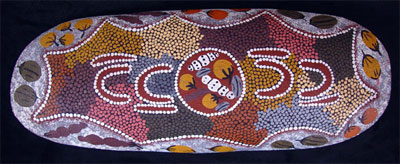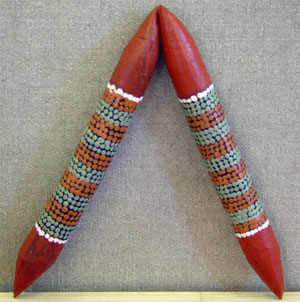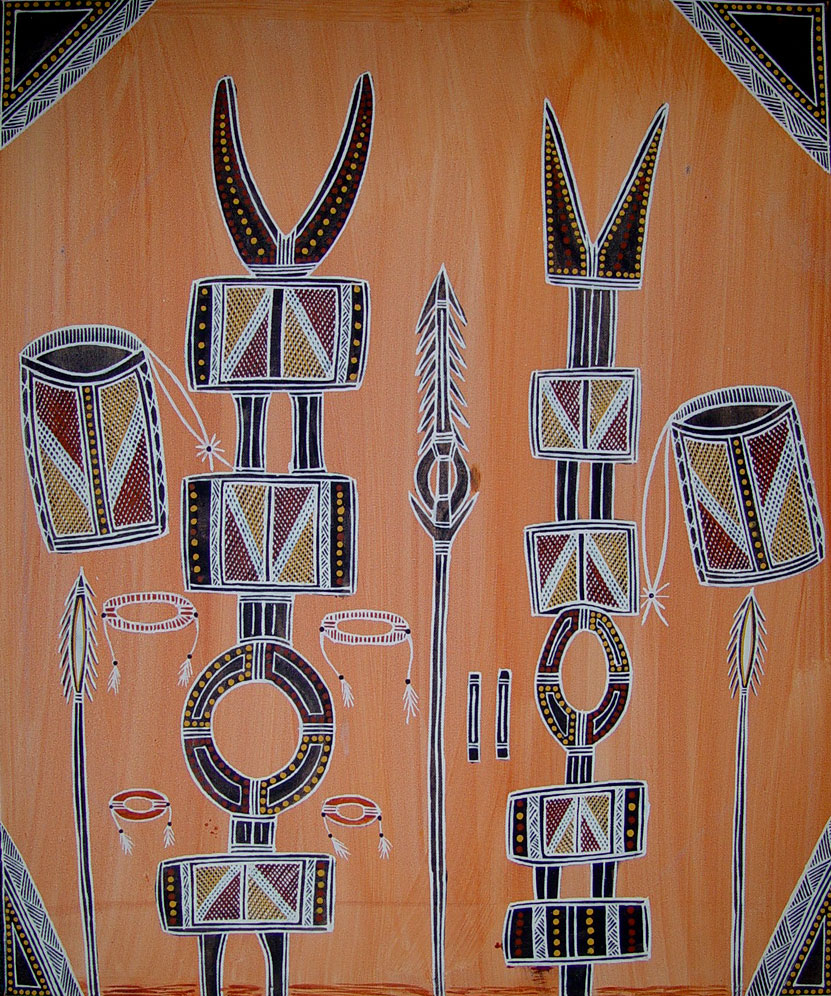Aboriginal Art Examples Explained

The earliest Aboriginal art examples have been found in the caves in which they sheltered.
They used crushed rocks called ochre and mixed it with water or animal blood to enrich the color.
Ochre is found in white red and yellow. The cave art were made by using fine grass and fingers and hands and Stenciling where the ochre was put it the mouth and then blown against the object such as a hand.
The ochre was also mixed with animal fat and used as body paint in ceremonies.
The aboriginal people had no written language and the symbols that were used to communicate their stories were also the basis for the body painting and their art
In Northern Australia in Arnhem Land they also did paintings on bark using ochre paints, which was stripped from trees and cured by drying.
Designs were applied to the bark with a thin piece of grass forming very fine patterns known as rarrk or crosshatching.
The people who lived further south in the desert also used ochre in a similar method for body painting and also for ground paintings.
These were made by crushing termite mounds then mixing it with ochre water or animal fat to form the sacred designs.
Flowers, feathers, leaves, plants and grass were also used to color the various designs.
The symbols used to communicate their stories and in their ceremonies were also used in sand drawings made with a stick in the desert sand while the community sang and danced around them.
Other Aboriginal art examples include Objects used for daily living and ceremony such as shields, boomerangs, womeras, didgeridoos, coolamons and clap sticks which also had designs and patterns carved into them or painted on them.
and also for ground paintings. These were made by crushing termite mounds then mixing it with ochre water or animal fat to form the sacred designs. Flowers, feathers, leaves, plants and grass were also used to color the various designs.

The symbols used to communicate their stories and in their ceremonies were also used in sand drawings made with a stick in the desert sand while the community sang and danced around them.
Other Aboriginal art examples include Objects used for daily living and ceremony such as shields, boomerangs, womeras, didgeridoos, coolamons and clap sticks which also had designs and patterns carved into them or painted on them.Women also used grasses such as the pandanus to weave baskets and dilly bags and made various shaped fish traps. They would boil the grass with various plant roots to obtain a variety of colors.
Further north we find more Aboriginal art examples.
On the Tiwi Islands the Tiwi people were isolated from the mainland when the seas rose about 4,000 yrs ago.
They developed a distinctive culture and art style based on their burial Pukamani ceremony with burial poles (Tutini).
They also painted bark bags (Tunga) and celebrated the Kulama (yam) ceremony which is a celebration of life.
They also carved figures of animals and birds from wood which are painted with the distinctive Tiwi designs.
These early expression of aboriginal art would later form the basis of today’s burgeoning Aboriginal art movement.In Arnhem Land the salt water people still paint on bark but only in a few communities.
Crushed ocher is still used however today it is mixed with acrylic binders to help it last longer.
Other communities now paint on art paper and canvas a much more portable and durable medium.
The women still weave beautiful baskets and fish traps and still use the traditional dyeing methods.
However many are now used as objects of art rather than their more utilitarian purpose.
Most of the works from Arnhem Land still display the traditional palette of the ochre colors brown red yellow white and black (from charcoal).
The people of the desert have transferred their symbols and designs of their dreaming stories and ceremonies to canvas using acrylic paint on canvas.
The earlier works were made using the earthy ochre colors. However as the movement grew the colors used expanded to just about anything you can imagine.
The Tiwi people have also adapted their designs to canvas and have also been hand-printing fabrics since the late 1960s. All of the communities also produce animal carvings, decorated didgeridoos, clap sticks, spears, coolamons and various animal and bird figures.
These items differ from each area and community.
You can tell fairly quickly the area in which an art object is from because of the styles used.
They all make up what we call Aboriginal art examples.



© Copyright 2010 All Rights Reserved No Reproduction Permitted Without Permission
Address : Michael Moriarty, PO Box 14, Barry Springs, NT, 0838 Australia